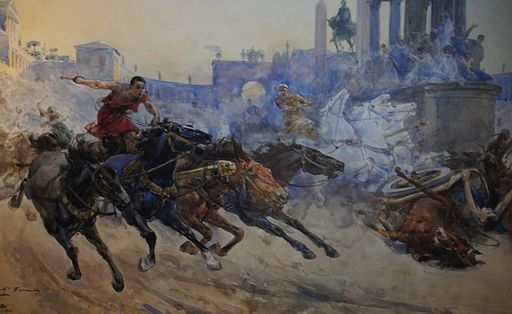The fleet battle chariot was also available as a sports model. It had room enough only for the driver, was light, maneuverable, and had small wheels that substantially lowered the center of gravity. This vehicle hugged the road, a special advantage when negotiating curves.
The first wagon races in history were probably held in the 13th century B.C. at Mycenaean funeral ceremonies. They served to honor the deceased, who had been prominent men in their lifetimes. From 680 B.C. on wagon races were also included in the program of the Olympic Games and enjoyed universal popularity. Because the victory was won by the owner of the team rather than by the driver, it was possible for women to win Olympic medals in ancient Greece, even though they were forbidden to participate themselves. In this way Spartan princess Kynisca had the distinction of being the first Greek woman to enter the annals of the Olympic Games.
In ancient Rome races were first rate entertainment that didn't cost a penny for its fans. Many of them were so anxious to see the races that they willingly sacrificed half the night to get a good seat in the biggest stadium of the empire, the Circus Maximus. They were just as enthralled by the races as today's Formula One fans in Monza or Hockenheim. Four teams fought to carry off the palm of victory: the Whites, the Reds, the Greens and the Blues (later joined briefly by a purple and a golden team). They were racing societies with an elaborate organization headed by powerful directors who decreed how much someone had to pay to hold a chariot race. The loyal fans identified with the racing societies and would place bets on their «club.» But even in those days fervent loyalty to a racing stable often turned into blind fanaticism. Attempts to help a club with magic spells belong to the more harmless, charming variety of fan activities - placing lead curse tablets in ditches, for instance, and hoping that the demons dwelling there would cause the opponent to take a spill during the race.
But what was it really like for race drivers in the hell's kitchen of the 600 meter long and 150 meter wide hippodrome? Reins wrapped tightly around their waist, the Roman charioteers drove their horses to the limit at breakneck speed. Anyone veering off course in the curve had to be lucky not to be run over by the chariots behind him. And if a racer fell out of his wagon, he had to able to cut off the reins quickly or be dragged to death by his own horses. The thrill-seeking Romans certainly found what they were looking for at the races, probably even more so than the race-hungry audience of today's Formula One circus. The lax rules provided plenty of excitement: jostling, ramming and running your opponent off the track were all legal. If a driver attacked his rival with a whip, he need not fear being warned, let alone disqualified. In the bitter man-to-man struggle, might made right.
The victor was celebrated as a hero and was awarded not only the palm but a generous purse as well. Charioteer Gaius Appuleius Diocles from Spain was as famous in his day as Michael Schumacher or Sebastian Vettel are in modern times, and he earned a fortune of more than 30 million sesterces in over a thousand winning races to become one of the super-rich of the times. Back then a quarter of a sesterce bought a pound of bread!

Photo: Hardy Holte; Formula 1-Race in South Africa in 1993, Alain Prost (in the leading car) and Michael Schumacher.
Just like today, drivers would switch teams if they were made a more lucrative offer. And so it came that certain drivers, like our megastar Gaius Appuleius Diocles, wore the silks of many different racing stables over the course of their career. A real fan remained true to his color, however, for he loved his team and stuck with them through thick and thin. Few of them had any idea of the shady deals being made behind the scenes. One man who wanted to be able to control the outcome of the races was the emperor Caligula, founder of the «Green» team. The horse-lover and megalomaniac occasionally had victorious opponents - horse and rider - discreetly eliminated. He even toyed with the idea of having his favorite stallion «Incitatus» named consul. The beloved animal was given a stall of marble and a sumptuous palace, but had to forgo the title, because the emperor was disposed of first.
Emperor Nero was another avid horse fan. He, too, was a passionate follower of the horse races, and even appeared himself as a driver in the Circus Maximus and at the Olympic Games. In the privacy of his own four walls he liked to play with a little team of four made out of ivory. The dissolute emperor Elagabulus had his own lewd twist on the game. Instead of horses, he had naked young woman harnessed to drive him through the palace.


